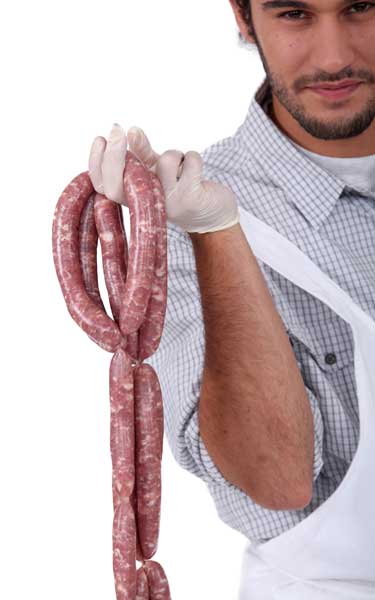Tips and Tricks

Recipes
Premixes are the easiest way to make a consistent product. All of our premixes for making sausages, burgers, cured meats, etc. have recipes attached. Simply click on the product picture/description for more information. If you prefer to make your products from scratch without the use of premixes, you will find recipes in our 'Books & DVD's' section.
Storage of Food Ingredients
All of our dry premixes, seasonings, boosters, spices and cures should be stored in a cool, dry, dark cupboard. Do not use curing products which are past their best-before dates or which have turned yellow due to light exposure, as it can lead to less than satisfactory results with the end product. Collagen sausage casings can be stored in the same way, making sure they are protected in a sealed package so they don't dry out and become brittle. Natural casings should be salted and refrigerated or frozen for long term storage.
Tips for Mincing Meat
Use a mincer with sharp blades and plates. Using blunt or damaged cutting gear is not efficient and can lead to the bruising and overheating of the meat, which encourages bacteria growth. Always cut pieces to be minced to a size that your mincer can easily handle. Generally, larger and more powerful mincers can handle larger pieces and faster feed-rates. Keep your meat as cold as possible throughout the mincing process, and immediately refrigerate or freeze when finished.
Tips for Filling Sausages
Ideally, a proper, stand alone sausage filler is the best way to fill sausages. Whilst it is possible to make do with a mincer (and filling cone) to fill sausages, the process is very slow and unnecessarily re-grinds the meat. It also restricts the operator to making thick sausage, as a mincer generally does not develop enough pressure to make thin sausages. Our hand-wound sausage fillers make the process a great deal faster and easier. As with all meat processing, the sausage meat should be kept cold at all times. It is important that the mix contains adequate moisture for the meat to flow smoothly into the casing. If it is overly difficult to turn the filler handle, do not force it. Your mix is too stiff and may need to have more water mixed into it prior to filling. Do not fill your sausages too tightly as they will be difficult to link and will be more prone to bursting when cooking.
Tips for Curing Meat
When mixing cure for pumping or soaking, follow the instructions carefully. If desired, the addition of salt to a brine mix can be varied slightly according to taste, but best results are assured if you do not differ too much from the recommended amount. Always dissolve cure in clean, cold water, in a food-grade container. Whilst some small products can simply be soaked in the cure, (ie. Fish, chicken, etc.), most larger meats need to have the brine injected into them using a brine pump and needle so that the cure can take effect quickly right through the whole product. Only inject fresh cure. Do not re-inject cure that has run out of the meat product as it will be tainted and watered down by blood and fluid from the meat. Rather than inject a lot of cure in only two or three spots, it is better to inject small quantities in numerous places. This will guarantee a more evenly cured product, and protect the muscle seams from damage. Large joints of meat will benefit from soaking in the cure/brine after pumping. When soaking, always keep the cure and the meat under refrigeration.
Vacuum Packaging Tips
Vacuum packaging is used to prolong the shelf-life of many food products. By restricting the oxygen available to the bacteria which causes foodstuffs to spoil, shelf life can be extended significantly. The achievable results will depend heavily on the type and condition of the food being packed. Vacuum packaging cannot rejuvenate food that is nearly spoiled, it merely slows down the spoiling process. The fresher the food is when it is packed, the longer it will last. With meat products, refrigeration is still required. Some people vacuum pack meat products so that they don't need to freeze them (ie for camping trips, etc). Others vacuum pack their meat prior to freezing to extend life and protect against freezer-burn. Chamber type vacuum packaging machines can be quite expensive to buy, but use a relatively cheap vacuum pouch. Domestic type machines are much more reasonably priced but use the more expensive 'channel' pouches. Do not be tempted to purchase the cheaper 'chamber type' vacuum bags for use with your domestic machine, as they simply will not work. As a general guide for meat longevity under vacuum, and assuming very fresh products held at optimal temperatures, you can expect to extend the refrigerated shelf life of most fresh beef products by up to 6 weeks. Lamb, pork and chicken will keep for 2 to 3 weeks. Cured or processed products such as salami, cabana, ham or even smoked fish can potentially last up to 8 weeks or more.
